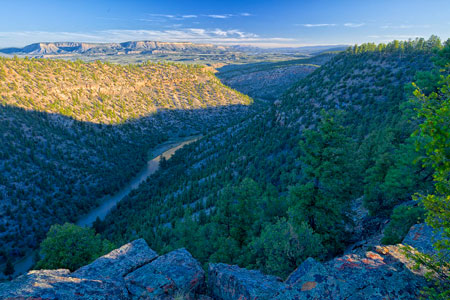This Place-Based Collaborative focuses on understanding and addressing the impacts of climate change and wildfires on New Mexico’s Rio Grande Fireshed, particularly in the Santa Fe Watershed. It seeks to advance knowledge through partnerships with Indigenous communities, NGOs, and local government, aiming to mitigate water insecurity and ecological transformations in the region.

Photo Credit: Bureau of Land Management
Firesheds provide a way to delineate where fires ignite and are likely to spread to communities and critical infrastructure such as water supply systems. We define New Mexico’s Rio Grande Fireshed as the Rio Grande hydrologic watershed, surrounding lands from which fire is likely to spread, and areas likely to be impacted by fire through mechanisms such as impacts to water supply or food-energy-water nexus interactions. The Rio Grande Fireshed is projected to increase between 1° and 6° F compared to the late 20th century over the next 50 years. This increase will have a transformative impact on New Mexico’s water supplies, as temperatures push headwater forests past ecological thresholds, facilitating forest die-off and making them increasingly vulnerable to catastrophic wildfire. This watershed serves about half of New Mexico’s population, including the cities of Albuquerque and Santa Fe, and surrounding agricultural areas, and rural communities. The resulting ecological transformation will create increasing societal challenges for these water users who depend upon functioning watersheds not only for water supply but also water storage, natural filtration, and flood control, among other ecosystem services. Fire has always been an important and necessary element of New Mexico’s forests, but it is now playing a new role, due to the interaction of climate change with misguided forest and rangeland management practices.
This Place-Based Collaborative aims to advance understanding of the characteristics, dynamics, and trajectories of this fireshed through convergent partnerships, particularly in the Santa Fe Watershed. Located within the Upper Rio Grande in northern New Mexico, the Santa Fe Watershed has been the home of Indigenous people since time immemorial; was colonized by the Spanish after first contact in the 1540s; and was transferred to the United States following the Treaty of Guadalupe Hidalgo in 1848. With an area of approximately 182,400 acres, the watershed drains from the west slopes of the Sangre de Christo Mountains (southern extent of the Rocky Mountains) from elevations exceeding 12,000 ft (3,660 m) to around 6,000 ft (1,830 m) at its confluence with the Rio Grande. The river is a critical source of water for Cochiti Pueblo, traditional acequias, rural County of Santa Fe residents, and the City of Santa Fe. The upper watershed is primarily forested with extremely high fire fuel loads and associated wildfire risks and is part of the dispossessed homelands of the Tesuque Pueblo, who manage adjacent lands to this day. The watershed is facing multiple stressors that drive water insecurity for its residents and the natural environment. Our work aims to advance understanding of the characteristics, dynamics, and trajectories of this watershed through convergent partnerships with Tribes, NGOs, the City of Santa Fe, and Santa Fe County.
Team Members
- Daniel Cadol (NM Tech)
- Kelly Jones (NMSU)
- Yolanda Lin (UNM)
- Melinda Morgan (UNM)
- Lani Tsinnajinnie (UNM)
- Marygold Walsh-Dilley (UNM)
Students
- Abelino Fernandez-Leger (NM Tech)
- Olivia Kelly (UNM)
- Joseph Kuljus (NM Tech)
- Desiree Loggins (UNM)
- William Mejía-Garcia (UNM)
- Marisol Meyer-Driovínto (UNM)
- Alyssa Mineau (NMSU)
- Lindsey Rotche (UNM)
- Cassidy Tawse-Garcia (UNM)